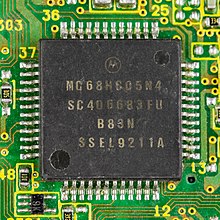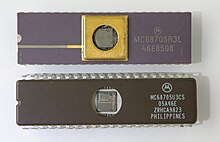Motorola 68HC05



The 68HC05 (also abbreviated as HC05) is a broad family of 8-bit microcontrollers from Motorola Semiconductor (later Freescale then NXP).
Like all Motorola processors that share lineage from the 6800, they use the von Neumann architecture as well as memory-mapped I/O. This family has five CPU registers that are not part of the memory: an 8-bit accumulator A, an 8-bit index register X, an 8-bit stack pointer SP with two most significant bits hardwired to 1, a 13-bit program counter PC, and an 8-bit condition code register CCR.
Among the HC05's there are several processor families, each targeted to different embedded applications.
The 68HC05 family broke ground with the introduction of the EEPROM-based MC68HC805C4 and MC68HC805B6 variants in the late 1980s. Using a serial bootloader, they could be programmed in-circuit with simple software running on a PC and a low current 19 V supply (no programmer required).
The HC05 series is now considered legacy and is replaced by the HC(S)08 MCU series.
Nomenclature
[edit]| MC6805xx | Motorola's first microcontroller family, implemented in HMOS |
| MC68705xx | MC6805 parts with EPROM instead of masked ROM |
| MC146805xx | MC6805 parts implemented in CMOS |
| MC1468705xx | MC146805 parts with EPROM instead of masked ROM |
| MC68HC05xx | MC6805 parts implemented in high-speed CMOS |
| MC68HC805xx | MC68HC05 parts with EEPROM |
